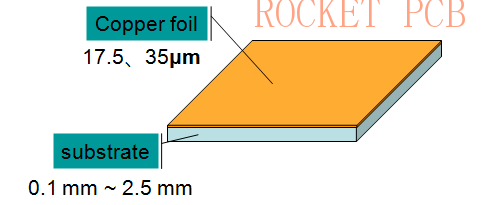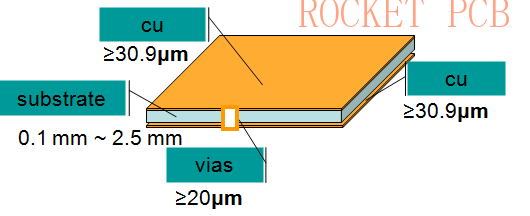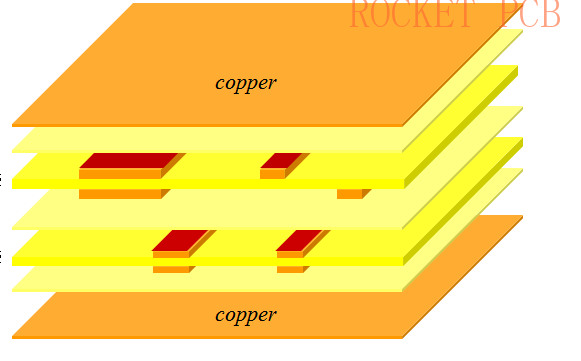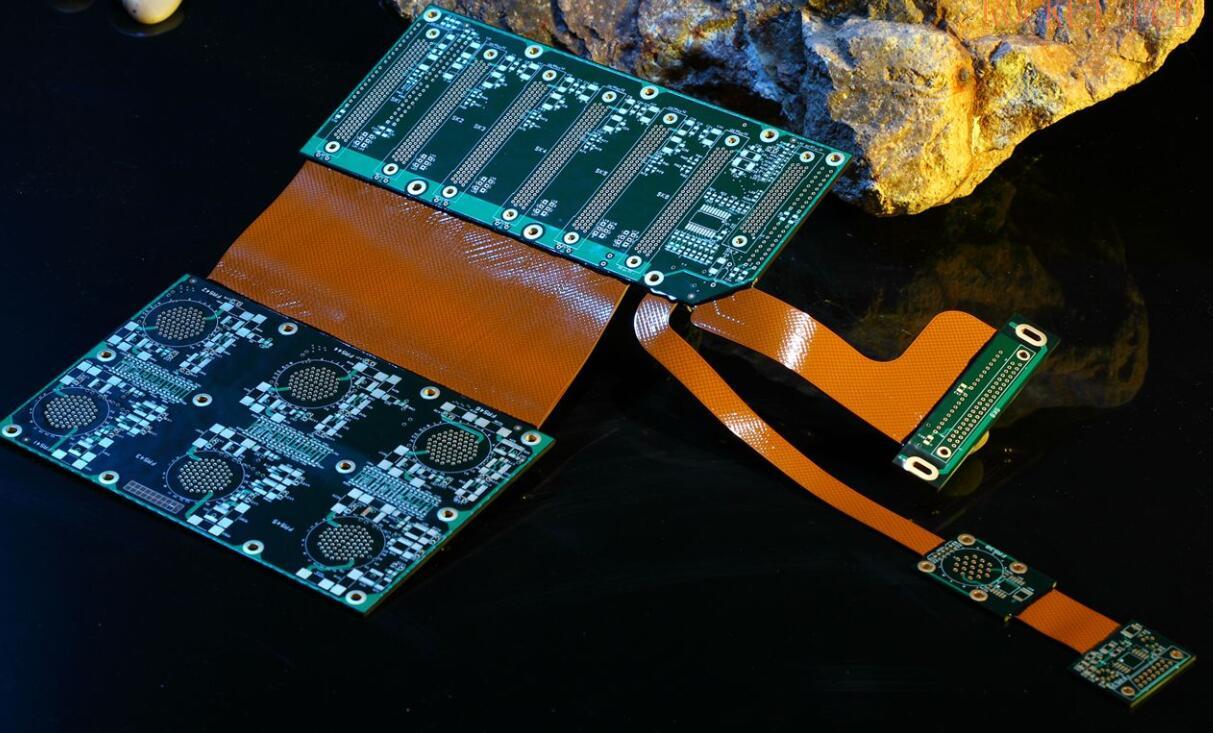What is PCB
Circuit boards, also known as printed circuit boards or PCB, can be found in every electronic device in the world today.
In fact, the PCB is considered to be the basis of electronic devices because it is the place where components are fixed in and connected to each other to make electronic devices work as expected. It is the carrier of electrical connection of electronic components. Because it is made by electronic printing, it is called a "printed" circuit board.
More complex circuit boards have multi-layer conductive copper tracks and interconnection features sandwiched between non-conductive materials. As technology advances and the demand for electronic devices becomes smaller and smaller as functions increase, engineers are breaking the boundaries of design and manufacturing capabilities to create circuit boards with finer features, more conductive layers, and smaller and denser components. These advanced circuit boards are often referred to as HDI or high-density interconnect PCB.
The most common non-conductive material circuit boards used to support etched copper tracks and conductive features are composites made of woven glass fiber cloth and epoxy resin.
Green (or any other color) is later added as one of the last steps in the circuit board manufacturing process. This additional color layer, called solder-mask, is used to protect the top and bottom of the copper, otherwise it will be exposed.
Although the common substrate made of fiberglass and epoxy resin is sufficient to meet the needs of many electronic devices, it may not be suitable for others, as not all devices are made for the same purpose, application or environment. Many electronic devices require PCB substrates to meet certain characteristics, so more advanced or special types of PCB substrates are needed.
These requirements can include a certain degree of temperature resistance, impact resistance and brittleness, high thermal conductivity, high TG, high frequency and high speed, etc..
With the development of PCB manufacturing technology, it becomes cheaper, faster and more convenient for professional manufacture of printed circuit boards.
Most PCB manufacturers need Gerber files to make circuit boards, which contain data, drawings, and specifications for the specific circuit board design to be produced.
PCB application
Most printed circuit boards used for simple electronic devices are simple and have only one layer. More complex hardware (such as computer graphics cards or motherboards) can have multiple layers, and existing technology can reach 68 layers. Although PCBs are most commonly associated with computers, they are also found in many other electronic devices, such as mobile phones , televisions, digital cameras and radios.
In addition to being used in consumer electronics and computers, various types of printed circuit boards are also used in many other electronic areas, including,
Industrial equipment
PCB is usually used in high-power industrial machinery.
If the current 1 oz copper printed circuit board does not meet the requirements, a thicker copper printed circuit board can be used. The use of thick copper PCBs include motor controller, high current battery charger and industrial load tester, etc.
Medical equipment
Today, electronics are denser and consume less power than previous generations, testing exciting new medical skills. Most medical devices use high-density PCB, this PCB is used to create the smallest and densest design. Because of its small scale and light weight, this helps to alleviate some of the constraints related to development devices in the medical field. From small devices such as pacemakers to large devices such as X-ray devices or CAT scanners, PCB has entered a variety of categories.
Lighting
Because LED-based lighting solutions are popular for their low power consumption and high efficiency, so is the aluminum pcb used to make them.
These PCBs are used as radiators to allow a higher level of heat transfer than standard PCBs.
These same aluminum PCB form the basis of high lumen LED applications and basic lighting solutions.
The automobile and aviation industries
Both the automotive and aerospace industries use flexible PCBs, which are designed to withstand the high vibration environments common in both fields. Depending on the specifications and design, they can also be very light, which is necessary for the manufacture of parts for the transportation industry.
They can also accommodate narrow spaces that may exist in these applications, such as inside the dashboard or behind the instrument on the dashboard.
PCB Types
PCB can be divided into different types according to structure, properties, and materials. Each has its own special manufacturing specifications and uses, such as single-layer PCB, double-layer PCB, multi-layer PCB, rigid PCB, flexible PCB, rigid-flex PCB, high-frequency PCB, aluminum-based PCB.
Single-sided PCB

A single-sided printed circuit board is a printed circuit board with a conductive pattern on only one side. In the most basic PCB, the parts are concentrated on one side and the wires are concentrated on the other side.
Because wires only appear on one side, we call this PCB one-sided PCB, a simple structure that means you can buy them at a low price.
Making one-sided materials is also relatively cheap, including FR-1, FR-2, FR-3, XBC, HB, CEM-1, CEM-3, FR-4 and so on.
(At present, both double-layer and multilayer boards use FR-4)
Low-cost, high-volume models mean they are commonly used in a variety of applications, including cameras, radios and stereo equipment, calculators, solid-state drives, printers and power supplies etc.
Double-layer PCB

The double-sided PCB boards is wired on both sides. However, in order to use both sides of the wire, there must be a proper circuit connection between the two sides. This kind of "bridge" between circuits is called guide hole (via). A guide hole is a small hole filled with or coated with metal on a pcb that can be connected to wires on both sides. Because double PCBs are twice as large as single board, and because wiring can be interlaced (can be wound to the other side), it is more suitable for circuits that are more complex than single board.
Strictly speaking, double-side PCB is a very important kind of PCB in circuit board. It has a wide range of applications, such as double-sided metal PCB board, Hi-Tg heavy copper circuit board, high-frequency PCB, mixed dielectric high-frequency double-sided circuit board, etc., a wide range of high-tech industries such as telecommunications, power supply, computer, industrial control, digital products, scientific and educational instruments, medical devices, automobiles, aerospace defense and so on can be used.
Multi-layer PCB

Multi-layer printed board, refers to more than two layers of printed board, it is composed of several layers of insulated substrate on the connection wire and assembly welding electronic components of the pad composition, not only has access to each layer of lines, but also has the role of mutual insulation, PCB multilayer board and single-panel, double-panel biggest difference is the increase of the internal power layer (to maintain the inner power layer) and the ground layer, power and ground network is mainly in the power layer wiring.
The key lies in how to optimize the wiring of the internal electric layer to make the wiring of the circuit board more reasonable and the electromagnetic compatibility better.
With the continuous development of SMT (surface mount technology) and the continuous introduction of a new generation of SMD (surface mount devices), such as QFP, QFN, CSP, BGA (especially MBGA),) make electronic products more intelligent and miniaturized, thus promoting the major reform and progress of PCB industrial technology.
With the rapid development of these processing technologies, the design of PCB has gradually developed to the direction of multi-layer and high-density wiring.
Multilayer PCB has been widely used in the production of electronic products because of its flexible design, stable and reliable electrical performance and superior economic performance.
Multi-layer PCB comes in a variety of sizes, ranging from four to ten or twelve. The largest multi-layer PCB ever has a thickness of 68 layers. Applications where multilayer PCBs will benefit include file servers, data storage, GPS technology, satellite systems, weather analysis, and medical equipment.
Rigid PCB
Rigid PCB is a printed circuit board made of rigid substrate material, such as epoxy glass cloth laminate, which prevents the circuit board from twisting.
Rigid PCB may constitute the maximum number of PCB produced. These PCB can be used anywhere you need to set the PCB itself to a shape and maintain it throughout the life of the device.
The rigid PCB can be a simple single-layer PCB to an eight-layer or high multi-layer PCB.
Flexible PCB

Flexible circuit board is a kind of printed circuit board with high reliability and high winding, which is made of polyimide or polyester film as substrate. This kind of circuit board has good heat dissipation, which can be bent, folded and flexed, and can be moved and stretched at will in three-dimensional space. FPC can be used to reduce the volume and realize lightweight, miniaturization and thinness, so as to realize the integration of component device and wire connection. FPC is widely used in computer, communication, aerospace and household appliances and other industries. Because they need to be printed on flexible materials, their manufacturing costs tend to be higher. Their flexibility saves cost and weight because a single flexible PCB can be used to cover areas that may require multiple rigid PCB.
Rigid-flex PCB

The rigid-flex PCB combines the advantages of the best of both worlds.
The rigid-flex PCB is composed of multi-layer flexible PCB and is attached to multiple rigid PCB layers. Rigid-flex PCB has many advantages.
For example, rigid-flexible PCBs have fewer parts than traditional rigid or flexible boards because the routing options for both boards can be combined into one board.
The combination of rigid and flexible board into a single rigid-flexible board can also achieve a more simplified design, thereby reducing the size and package weight of the overall board.
The main applications of rigid-flex PCB include: aerospace, such as high-end aircraft-mounted weapon navigation systems, advanced medical equipment, digital cameras, portable cameras and high-quality MP3 players.
Rigid-flex PCB is most commonly used in the manufacture of military aircraft and medical equipment. Rigid-flex PCB brings great benefits to the design of military aircraft, because it not only improves the reliability of the connection, but also reduces the weight, of course, the benefits brought by the overall size can not be ignored.
However, due to the mixed use of a variety of materials and multiple manufacturing steps, the processing time of rigid-flex board is longer and the production cost is higher.
When making multi-layer rigid-flex composite board, the processing technology of the flexible layer is quite different from that of the external FR4 layer.
The various layers made of different materials must be gathered together by lamination and then drilled and electroplated.
As a result, it may take 5 to 7 times longer to make a typical four-layer rigid-flex printed circuit board than a standard four-layer rigid printed circuit board.
High frequency PCB
Generally speaking, high frequency can be defined as the frequency above 1GHz. High frequency PCB materials usually include FR4 grade glass fiber reinforced epoxy laminates, polyphenylene oxide (PPO) resins and Teflon.
When selecting high frequency PCB board and its corresponding type of PCB connector, many aspects need to be considered, including dielectric constant (DK), dissipation, loss and dielectric thickness.
The most important of these is the Dk of the material under discussion. Materials with the possibility of high permittivity changes usually experience impedance changes, which can destroy the harmonics that make up the digital signal and lead to the overall loss of digital signal integrity-high-frequency PCB is designed to prevent one of these situations.
At present, polytetrafluoroethylene ((PTFE)) is widely used in the manufacture of high-frequency PCB, also known as Teflon, whose frequency is usually higher than that of 5GHz.
In addition, FR4 or PPO substrates can be used for product frequency between 1GHz~10GHz. High-frequency electronic equipment is the current development trend, especially in wireless networks.
With the rapid development of satellite communications, information products are moving towards high speed and high frequency. Therefore, the development of new products always requires the use of high-frequency substrate, satellite systems, mobile phone receiving base stations, etc., these communication products must use high-frequency PCB.
Aluminum-base PCB

Aluminum substrate is a kind of metal-based copper clad laminate with good heat dissipation function. Generally, the single board is composed of three layers, namely circuit layer (copper foil), insulating layer and metal base layer. It is also designed for double-sided aluminum substrates for high-end use.
The heat dissipation of LED is the biggest headache for LED manufacturers, but aluminum substrate can be used because of its high thermal conductivity and good heat dissipation, which can effectively export internal heat.
Aluminum substrate is a unique metal-based copper clad laminate, which has good thermal conductivity, electrical insulation and mechanical properties. When designing, it is also necessary to keep the PCB close to the aluminum base, so as to reduce the thermal resistance caused by the filling glue.
The aluminum backing has an insulating material, which is designed to have low thermal resistance, which means that less heat is transferred from the insulating material to the backing.
After the insulation is applied, a copper circuit layer with a thickness of 1 oz to 10 oz will be applied. All these advantages make aluminum PCB an excellent choice for applications that require high power output within very strict tolerances, including traffic lights, automotive lighting, power supplies, motor controllers and high current circuits.
In addition to these main applications, aluminum PCB can also be used in applications that require high mechanical stability, or where PCB may withstand high levels of mechanical stress.
Rocket PCB meets all your PCB production needs
Whether you need a simple single-layer PCB or a complex high-level multi-layer PCB, Rocket PCB can make your idea come true.
We provide manufacturing services for all kinds of PCB-all kinds of PCB types, all kinds of PCB materials. Such as high-frequency PCB and aluminum PCB,HDI PCB, backplane PCB and so on.
Get the FR4 PCB manufacturing price in a few minutes
To get the manufacturing price of a dedicated PCB, such as rigid PCB, aluminum PCB, Rogers PCB flexible PCB, etc., you only need to send your Gerber file and material and quantity requirements on the message board. Or you can contact us directly by email. We will give you the price as soon as possible.
Our core strengths of PCB prototyping services help you get the right PCB design before full production. According to the PCB requirements, when you need to quickly complete quality prototyping, most prototypes PCB can be completed within 5 days.
Get real-time quotes for Quick turn PCB prototypes
Once your PCB prototype is complete, we will also provide assembly services. According to your unique needs, we can complete all the work from prototype assembly to commissioned PCB assembly, turnkey PCB assembly and full assembly.
We can also accommodate a variety of products, from small batches, highly mixed components to large quantities of assembly.
As part of quality control, we provide manufacturability (DFM) test designs. We can also conduct specific functional tests according to your requirements to ensure that the PCB manufactured conforms to the design specifications that created them.





